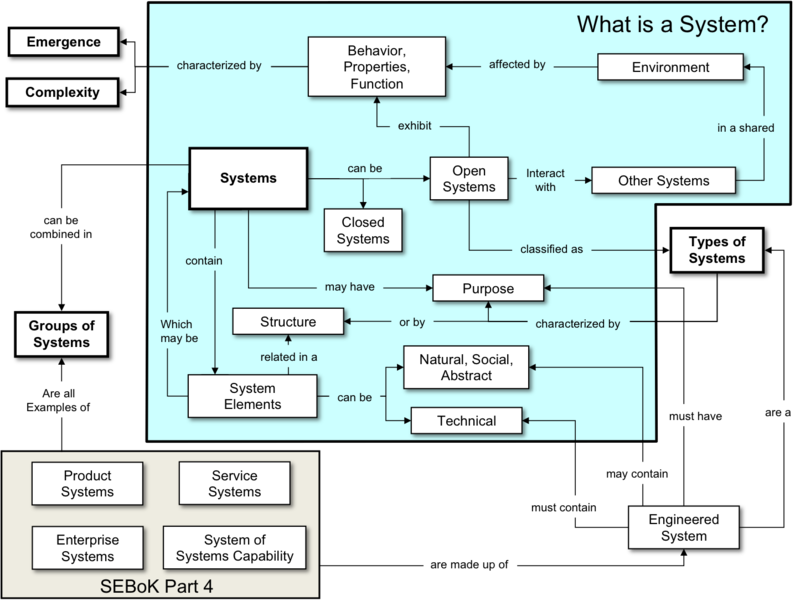Difference between revisions of "Systems Engineering Fundamentals"
(→Topics) |
(→Topics) |
||
| Line 5: | Line 5: | ||
==Topics== | ==Topics== | ||
Each part of the SEBoK is divided into KAs, which are groupings of information with a related theme. The KAs in turn are divided into topics. This KA contains the following topics: | Each part of the SEBoK is divided into KAs, which are groupings of information with a related theme. The KAs in turn are divided into topics. This KA contains the following topics: | ||
| − | *[[Introduction to Fundamentals]] | + | *[[Introduction to Systems Fundamentals]] |
*[[Engineered Systems]] | *[[Engineered Systems]] | ||
*[[Complexity]] | *[[Complexity]] | ||
Revision as of 14:31, 17 May 2019
This knowledge area (KA) provides a guide to some of the most important knowledge about a system, which forms part of systems thinking and acts as a foundation for the related worlds of integrative systems science and systems approaches to practice.
This is part of the wider systems knowledge, which can help to provide a common language and intellectual foundation and make practical systems concepts, principles, patterns and tools accessible to systems engineering (SE) as discussed in Part 2: Foundations of Systems Engineering.
Topics
Each part of the SEBoK is divided into KAs, which are groupings of information with a related theme. The KAs in turn are divided into topics. This KA contains the following topics:
- Introduction to Systems Fundamentals
- Engineered Systems
- Complexity
- Emergence
- Evolution of Fundamentals
Introduction
The word system is used in many areas of human activity and at many levels. But what do systems researchers and practitioners mean when they use the word system? Is there some part of that meaning common to all applications? The following diagram summarizes the ways in which this question is explored in this KA.
The concepts of open system and closed system are explored. Open systems, described by a set of elements and relationships, are used to describe many real world phenomena. Closed systems have no interactions with their environment. Two particular aspects of systems, complexity and emergence, are described in this KA. Between them, these two concepts represent many of the challenges which drive the need for systems thinking and an appreciation of systems science in SE.
Some systems classifications, characterized by type of element or by purpose, are presented.
Within the SEBoK an engineered system is defined as encompassing combinations of technology and people in the context of natural, social, business, public or political environments, created, used and sustained for an identified purpose. The application of the Systems Approach Applied to Engineered Systems requires the ability to position problems or opportunities in the wider system containing them, to create or change a specific engineered system-of-interest, and to understand and deal with the consequences of these changes in appropriate wider systems. The concept of a system context allows all of the system elements and relationships needed to support this to be identified.
The discussions of engineered system contexts includes the general idea of groups of systems to help deal with situations in which the elements of an engineered system are themselves independent engineered systems. To help provide a focus for the discussions of how SE is applied to real world problems, four engineered system contexts are introduced in the KA:
- product system context
- service system context
- enterprise system context
- system of systems (sos) context
The details of how SE is applied to each of these contexts are described in Part 4: Applications of Systems Engineering.
References
Works Cited
None.
Primary References
Bertalanffy, L., von. 1968. General System Theory: Foundations, Development, Applications, rev. ed. New York, NY, USA: Braziller.
Magee, C. L., O.L. de Weck. 2004. "Complex System Classification." Proceedings of the 14th Annual International Council on Systems Engineering International Symposium, 20-24 June 2004, Toulouse, France.
Rebovich, G., and B.E. White (eds.). 2011. Enterprise Systems Engineering: Advances in the Theory and Practice. Boca Raton, FL, USA: CRC Press.
Sheard, S.A. and A. Mostashari. 2009. "Principles of Complex Systems for Systems Engineering". Systems Engineering, 12(4): 295-311.
Tien, J.M. and D. Berg. 2003. "A Case for Service Systems Engineering". Journal of Systems Science and Systems Engineering, 12(1): 13-38.
Additional References
None.
